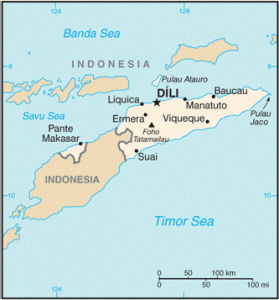 For many, seeing and visiting world cultural heritage might only be glimpses of the past; lives and cultures that once were. However, in many countries in the world, national cultural heritage help to ensure better lives and future for the citizens of the country. One example of this situation and the opportunity is in East Timor or the Democratic Republic of Timor-Leste.
For many, seeing and visiting world cultural heritage might only be glimpses of the past; lives and cultures that once were. However, in many countries in the world, national cultural heritage help to ensure better lives and future for the citizens of the country. One example of this situation and the opportunity is in East Timor or the Democratic Republic of Timor-Leste.
About 37% of Timor-Leste’s population lives below the international poverty line which means living on less than U.S. $1.25 per day and about 50% of the population is illiterate. However, Timor-Leste’s rich cultural heritage and beautiful landscapes have the potential for tourism which could help to improve the lives of many citizens. Tourism development is one way of helping preserve the national heritage treasures while also diversifying the economy, and bringing employment and rural development to some of the poorest parts of the country.
The World Bank has already identified over ninety cultural heritage sites with tourism potential and at the same time has recognized that a major challenge is that about 70 percent of the country’s population of one million people live in rural areas, often with limited access to transportation and a lack of communication infrastructure. A poor road network and limited attention to the country’s cultural heritage is a major constraint. However, the World Bank is supporting the rehabilitation of roads and working with local communities to identify tourism potential of important heritage sites. The World Bank is working with the Ministry of Tourism and local communities to identify cultural heritage sites along the Dili, Aileu and Ainaro road. The Ninety sites that have been identified along with their local significance, potential management opportunities and constraints to develop sustainable tourism have been studied. Under the Road Climate Resilient Project, the Bank aims at improving the 110km road between Dili and Ainaro, with work expected to start by early 2014. This road serves as a vital link between the north and the south of the country, in some of the poorest and most remote parts as reported by the World Bank.
Timor-Leste has had a turbulent history and has a market economy that used to depend upon exports of a few commodities such as coffee, marble, oil and sandalwood. However, the economy grew by about 10% in 2011, and at a similar rate in 2012 mostly due to oil industry.
The history of Timor-Leste:
The Portuguese began to trade with the island of Timor in the early 16th century and colonized it in mid-century. Skirmishing with the Dutch in the region eventually resulted in an 1859 treaty in which Portugal ceded the western portion of the island. Imperial Japan occupied Portuguese Timor from 1942 to 1945, but Portugal resumed colonial authority after the Japanese defeat in World War II. East Timor declared itself independent from Portugal on 28 November 1975 and was invaded and occupied by Indonesian forces nine days later. It was incorporated into Indonesia in July 1976 as the province of Timor Timur (East Timor). An unsuccessful campaign of pacification followed over the next two decades, during which an estimated 100,000 to 250,000 individuals lost their lives. On 30 August 1999, in an UN-supervised popular referendum, an overwhelming majority of the people of Timor-Leste voted for independence from Indonesia. However, in the next three weeks, anti-independence Timorese militias – organized and supported by the Indonesian military – commenced a large-scale, scorched-earth campaign of retribution. The militias killed approximately 1,400 Timorese and forcibly pushed 300,000 people into western Timor as refugees. Most of the country’s infrastructure, including homes, irrigation systems, water supply systems, and schools, and nearly 100% of the country’s electrical grid were destroyed. On 20 September 1999, Australian-led peacekeeping troops deployed to the country and brought the violence to an end. On 20 May 2002, Timor-Leste was internationally recognized as an independent state. In 2006, internal tensions threatened the new nation’s security when a military strike led to violence and a breakdown of law and order. At Dili’s request, an Australian-led International Stabilization Force (ISF) deployed to Timor-Leste, and the UN Security Council established the UN Integrated Mission in Timor-Leste (UNMIT), which included an authorized police presence of over 1,600 personnel. The ISF and UNMIT restored stability, allowing for presidential and parliamentary elections in 2007 in a largely peaceful atmosphere. In February 2008, a rebel group staged an unsuccessful attack against the president and prime minister. The ringleader was killed in the attack, and most of the rebels surrendered in April 2008. Since the attack, the government has enjoyed one of its longest periods of post-independence stability, including successful 2012 elections for both the parliament and president. In late 2012, the UN Security Council voted to end its peacekeeping mission in Timor-Leste and the peace keeping forces departed the country by the end of the year.















